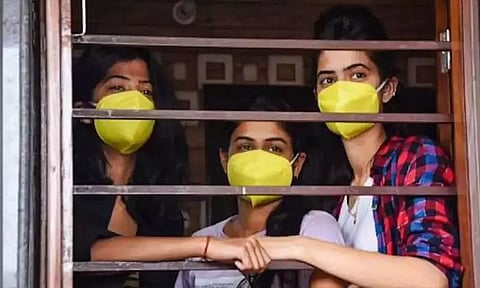
- Home
- Live Blog
- Breaking News
- Top Headlines
- Cities
- NE News
- Sentinel Media
- Sports
- Education
- Jobs

Guwahati: In the wake of a steady rise in the number of COVID-19 cases, the Central Government has issued a set of revised guidelines for home isolation and has now included asymptomatic positive patients too on the list of mild or pre-symptomatic cases who can quarantine themselves at home. However, patients suffering from immunity diseases (such as AIDS, cancer therapy) will not be eligible for home isolation.
Following the new guideline, patients under home isolation will stand discharged after 10 days of onset of symptoms and no fever for three days. The revised guideline expressly stated that "Patient under home isolation will stand discharged after 10 days of symptom onset and no fever for 3 days. Thereafter, the patient will be advised to isolate at home and self-monitor their health for a further 7 days." The guideline further asserts that there will be no need for testing after the home isolation period is over.
In the case of elderly patients who are aged more than 60 years and those with co-morbid conditions such as hypertension, diabetes, heart disease, chronic lung/liver/kidney disease, and cerebrovascular disease, they shall "only be allowed home isolation after proper evaluation by the treating medical officer".
Furthermore, the revised guidelines state that "patients suffering from immune-compromised status (HIV, transplant recipients, cancer therapy, etc) are not eligible for home isolation."
The Centre has laid down three additional symptoms concerning asymptomatic, very mild, and pre-symptomatic patients under home isolation and they have to seek medical attention. The symptoms are: dip in oxygen saturation (SpO2 < 95%), slurred speech/seizures, and weakness or numbness in any limb or face.
In consonance with the previous guideline, the patients need to seek medical attention in cases of the following symptoms: difficulty in breathing, persistent pain/pressure in the chest, mental confusion or inability to arouse, and developing bluish discolorations of lips/face.
The revised guidelines further reiterate that district surveillance should monitor all the home isolation cases. "The health status of those under home isolation should be monitored by the field staff/surveillance teams through personal visit along with a dedicated call center to follow up the patients daily. The clinical status of each case shall be recorded by the field staff/call center (body temperature, pulse rate, and oxygen saturation). The field staff shall guide the patient on measuring these parameters and provide the instructions (for patients and their caregivers)."
The guideline asserts that this mechanism to monitor those under home isolation daily shall be strictly adhered to. Moreover, the revised guideline expounded that "details about patients under home isolation should also be updated on the COVID-19 portal and facility app (with DSO as the user)." The Senior State and District officials will be tasked with the duty to monitor the update of records.